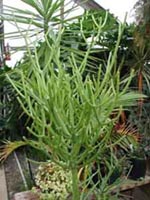Resource Library
Plant of the Week: Pencil Cactus (Milkbush)
The University of Arkansas System Division of Agriculture does not promote, support or recommend plants featured in "Plant of the Week." Please consult your local Extension office for plants suitable for your region.
Plant of the Week
Pencil Cactus, Milkbush
Latin: Euphorbia tirucalli

As my wife drove me to the hospital, I decided I must not be dying because I saw neither a flashback of my life’s many regrets nor the infamous bright light at the end of a dark tunnel.
But, as scary as barely being able to breathe is, an up-close-and-personal experience with a poisonous plant was very educational. The plant, pencil cactus (Euphorbia tirucalli), was the culprit in this late-night adventure.
What are the characteristics of a pencil cactus?
Pencil cactus is not a true cactus but a member of the Euphorbia family from tropical parts of Africa and India. In nature, it grows as a 30-foot tall, leafless tree with pencil-size green branches that function in photosynthesis. Tiny leaves appear at the ends of new branches when new growth occurs, but they quickly fall.
Pencil cactus is grown as a large houseplant that reaches ceiling height when given a couple years in a good size container. Plants usually have a narrowly upright form with branch tips that begin to droop as the plants gain size. I’ve never seen it flower.
Is pencil cactus sap toxic?
Now for the bad news. One of the common names for this Euphorbia is Milkbush, a well deserved name. Like all members of the Euphorbia family, milkbush produces the familiar white latex when the stem is cut, but none in my experience produce the copious amounts of sap that this succulent produces. The toxic component found in the sap are thought to be diterpene esters.
My problems began when I stopped by the greenhouse to take a bunch of cuttings from this interesting plant for an upcoming plant sale. I managed to get sap spread all over my hands and near one eye.
Symptoms of an adverse reaction began within an hour of exposure, starting with burning of the eye. The problem quickly spread to the other eye, and then my lips became numb about two hours into the ordeal. About this time, I experienced the worst case of fidgets ever encountered. Shortness of breath began after about four hours. With a quick visit to the emergency room and a shot of antihistamine, recovery was almost instantaneous.
Mine was a classic case of anaphylactic shock, the same kind of problem people allergic to peanuts, soy products or dairy products experience.
There is no doubt that plant poisonings do occur, but the incidence of fatality is so low that it is not statistically different than that of being hit by a meteor. However, a high percentage of the 2.3 million cases of human exposure reported to the nation’s network of Poison Control Centers in 2000 were plant related.
The majority of these were cases of toddlers taking a bite out of a plant and then a panicked parent making a dash for the nearest hospital. While some ornamental plants are poisonous, the likelihood of a child ingesting a sufficiently large dose to have an adverse reaction is remote.
My experience points out the difficulty of developing a completely accurate and universally accepted list of poisonous plants. Most would never consider peanuts to be poisonous. And to the majority of people, pencil cactus presents no serious risk, but I now treat it with a great deal of respect. All plants are a witches brew of organic compounds.
With small children it is always the best policy to keep plants out of the way and to teach them at the earliest possible age to put only food in their mouth.
By: Gerald Klingaman, retired
Extension Horticulturist - Ornamentals
Extension News - February 1, 2002
The University of Arkansas System Division of Agriculture does not maintain lists of retail outlets where these plants can be purchased. Please check your local nursery or other retail outlets to ask about the availability of these plants for your growing area.